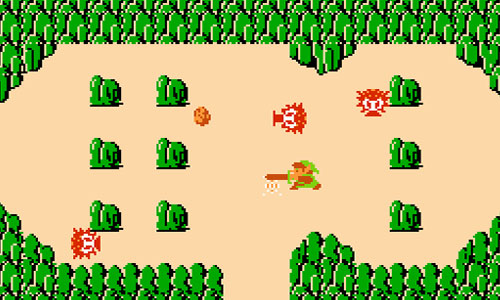Camera and Projections

As a fan of action adventure games from a young age, the experience of controlling a character was what brought me into video games. The industry standard during my childhood had a few ideas with camera angles. The picture to the right from the first Legend of Zelda game (1986) shows the playable character only able to move within the confines of the current map location. The stagnant camera never moves from its position, so all information that is required to play the current map is processed by the player. As the player moves off screen the game receives the co-ordinates of the player moving off the screen and transitions to the new screen with the matching co-ordinates. When this happens, the camera is reset and centred back into the middle of the new map. This style of camera projection defined some of the most prominent mid 80s games with Legend of Zelda (1986), Castlevania (1986) and Metroid (1986).

Another alternative to this style of camera movement is the tracking approach or side on view. To the left is a screenshot of Super Mario Brothers 3 (1988) in which the camera tracks the player’s movement across the screen. This approach was used by many developers to allow for action adventures to have long drawn level designs. Side scrollers became the pinnacle of design in the late 80s and early 90s seeing top releases with the Super Mario series, the Legend of Zelda series, Mega man and many other greats during the time. A personal preference of mine when it came to these types of games was being able to evaluate what is going on in the screen and making a split-second decision on how to proceed with the content available. A further reason for my preference for this style of camera is not having to manipulate it. For many casual players of video games, this can be a hurdle to overcome, as learning movement and camera movement as two separate tasks can be tedious and often overwhelming. The above descriptions of camera use do not require the player to control the camera movement in order to play the game.
References:
Konami 1986, Castlevania, video game, Nintendo Entertainment System, Konami.
Nintendo Entertainment Analysis and Development Division 1986, The Legend of Zelda, video game, Nintendo Entertainment System, Nintendo.
Nintendo Entertainment Analysis and Development Division 1988, Super Mario Bros. 3, Nintendo Entertainment System, Nintendo.
Nintendo Research and Development No. 1 Department 1986, Metroid, Nintendo Entertainment System, Nintendo.